


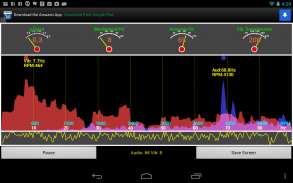
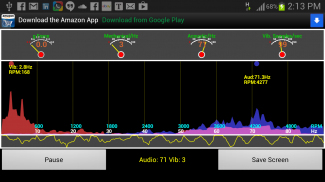
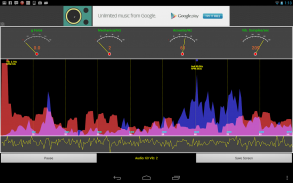
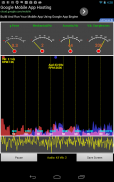
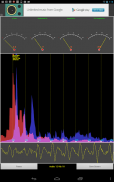
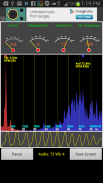
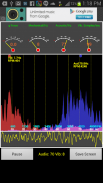
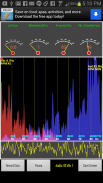
Vibrations! (Ads)

Descrizione di Vibrations! (Ads)
Vibrations is an app for measuring mechanical vibrations and acoustic noise from engines, the environment, machines, and other equipment. (Ads supported.)
This is (currently) the only app that combines acoustic *and* mechanical measurements!
Uses: monitoring vehicle engine vibration, monitoring vibrations of household appliances (dishwasher, refrigerator, waste disposal units, clothes dryers, etc.), measuring g-force in moving vehicles, helping to identify failing gears, evidenced by knocking sounds, modes, etc..
Vibrations uses data streams from the built-in accelerometer and microphone: it calculates two simultaneous FFTs, one from the mechanical measurements, one from the audible measurements. It then shows the frequency spectra on the screen. The frequency axis is labelled in Hz and RPM (revolutions per minute).
Four on-screen software gauges give an overview of the measurements:
1) The g-force (excluding gravity), which measures acceleration
2) The frequency of the current peak in the mechanical/vibration noise
3) The frequency of the current peak in the acoustic noise
4) The sample rate at which mechanical vibrations are being measured
Screen shots can be taken using the "Save Screen" button, and stored to the SD card.
Time series of accelerometer data (up to 20 seconds) can be recorded and saved using the "Record Data" button. Since data are continually being gathered, the recorded data written to the file actually starts a second or so *before* the button was pressed. Recording can be interrupted while in progress, and the data discarded or saved. Otherwise, the recording will automatically terminate after 20 seconds have elapsed, and the data discarded or saved then.
Data collection for the screen and record mode can be paused and resumed using the "Pause"/"Resume" button.
Please contact me if you have suggestions for improvements or enhancements (or to report problems).
Also, please note that the frequency limit of the mechanical vibration measurement is limited by the maximum rate that accelerometer samples can be obtained from the Android device: this typically varies from device to device - e.g. on the Nexus 7 and 10 tablets, the rate is ~200 samples/sec, giving a maximum frequency measurement of ~100Hz or 6000 RPM. On the Galaxy S3 the rate is ~100 samples/sec, giving a maximum frequency of ~50Hz.Vibrazioni è un app per misurare le vibrazioni meccaniche e rumore acustico prodotto dai motori, l'ambiente, le macchine e altre attrezzature. (Annunci supportati.)
Questo è (al momento) l'unica app che combina acustiche * e * misure meccaniche!
Usi: monitoraggio delle vibrazioni del motore del veicolo, il monitoraggio vibrazioni di elettrodomestici (lavastoviglie, frigo, unità di smaltimento dei rifiuti, asciugatrici, ecc), che misura G-Force in veicoli in movimento, contribuendo a identificare gli ingranaggi in mancanza, evidenziato da suoni che bussano, modalità, ecc ..
Vibrazioni utilizza flussi di dati dall'accelerometro integrato e microfono: si calcola due FFT simultanei, uno per le misure meccaniche, uno per le misurazioni acustiche. Esso poi mostra gli spettri di frequenza sullo schermo. L'asse delle frequenze è etichettato in Hz e RPM (giri al minuto).
Quattro indicatori di software su schermo offrono una panoramica delle misure:
1) Il G-Force (escluso gravità), che misura l'accelerazione
2) La frequenza del picco di corrente nel rumore meccanico / vibrazione
3) La frequenza del picco di corrente nel rumore acustico
4) La frequenza di campionamento con cui vengono misurate le vibrazioni meccaniche
Le schermate possono essere effettuate utilizzando il pulsante "Salva schermo", e memorizzati sulla scheda SD.
Serie temporali di dati accelerometrici (fino a 20 secondi) può essere registrato e salvato utilizzando il pulsante "set di dati". Dal momento che i dati vengono continuamente raccolti, i dati registrati scritti nel file inizia in realtà un secondo o poco più * prima * è stato premuto il pulsante. La registrazione può essere interrotta mentre è in corso, ed i dati scartati o salvato. In caso contrario, la registrazione terminerà automaticamente dopo 20 secondi sono trascorsi, ed i dati eliminati o salvati allora.
La raccolta dei dati per lo schermo e la modalità di registrazione può essere messa in pausa e ripresa con il pulsante "Riprendi", "Pausa" /.
Vi prego di contattarmi se avete suggerimenti per miglioramenti o miglioramenti (o per segnalare problemi).
Inoltre, si ricorda che il limite di frequenza della misurazione delle vibrazioni meccaniche è limitata dalla velocità massima che i campioni accelerometrici possono essere ottenuti dal dispositivo Android: questo genere varia da dispositivo a dispositivo - ad esempio sul Nexus 7 e 10 compresse, il costo è di ~ 200 campioni / sec, dando una misura massima frequenza di 100Hz ~ o 6000 RPM. Su il Galaxy S3, il costo è circa 100 campioni / sec, dando una frequenza massima di 50Hz ~.

























